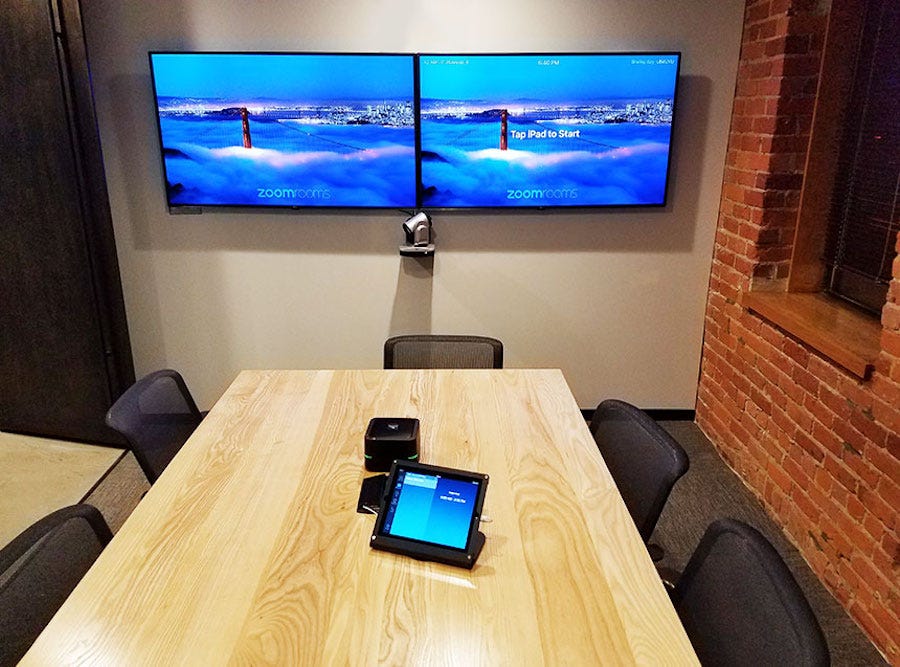Best Ways to Use Zoom In Small Conference Rooms
Imagine you go back into the office and you have to speak with a colleague who is working from home. You have another colleague in the office who you also have joining this meeting, but they sit across the way from you. The two of you leave your desks with just a cell phone and are able to see which conference rooms are available so you book a two person meeting room, but when you walk in, there is a display on the wall and a Polycom Phone sitting on the table. You want to see what your colleague at home has been working on, but you don’t have a way to view the content easily from what is provided in your conference room.
So you go back to your desk, grab your laptop and join at your workspace alone. YOu’ve been doing this style of meeting for 12+ months and you finally wanted to be able to interact with them in person.
 Imagine a difference scenario now where you have a team of 8 people of which 6 are in the office. Your leader has reserved a conference room named Silicon Valley for a meeting. You and your buddies walk down the hall with nothing but a pen and paper. You sit down at an 8 person table and on the iPad controller you’re able to see your meeting invite that was sent from your desk. You click the JOIN button and enter the video conference call. YOur two colleagues sitting at home are already speaking when the leader shuts the door and everyone silences.
Imagine a difference scenario now where you have a team of 8 people of which 6 are in the office. Your leader has reserved a conference room named Silicon Valley for a meeting. You and your buddies walk down the hall with nothing but a pen and paper. You sit down at an 8 person table and on the iPad controller you’re able to see your meeting invite that was sent from your desk. You click the JOIN button and enter the video conference call. YOur two colleagues sitting at home are already speaking when the leader shuts the door and everyone silences.
The leader stays standing and pacing around the room. The mic is able to follow the speaker’s voice through using beam tracking technology. The camera is properly positioned where they are able to see the speaker walk up to an interactive white board on the back wall and shatar a virtual whiteboard session. The person sitting at the controller selects the camera preset for the whiteboard speaker who is standing 20’ away from the camera. The camera automatically adjusts the FOV by pan tilt and zoom into the speaker at the interactive whiteboard.
The content written on the board is shared with both the people sitting in the room along with everyone on the far end. The technology in the room is seamlessly and easily used by the most technology challenged individual who is standing at the interactive display.
No longer do you have to bring your laptop and other personal AV technology to the conference room. Your company has built AV technology into all of your conference rooms because your team doesn’t just have in-person meetings anymore. The reality is that if you don’t accommodate the remote participants, you’re letting your team down. Since the start of 2021, we have helped our customers with the smallest and simplest conference rooms accommodate the remote participant through Zoom Room video conferencing hardware. We have used dozens of different hardware types from Neat to Crestron to Aver or Biamp. Your small and medium spaces can be simple or complex. It all depends on how you set them up. These rooms are and will be the most use rooms that need good AV.
Recent Posts
- AI-Powered Humanoid Robots: Transforming Business, Homes & Connectivity
- Top IT & Network Design Consultants in Boston and New England: Macronet Services
- Top AI Consultants in New England: Why New Hampshire’s Macronet Services Shines in Boston and Beyond
- IXPs in the US and Internet Peering
- Top Tips for a Winning Agentic AI Contact Center for 2025
Archives
- June 2025
- May 2025
- April 2025
- March 2025
- February 2025
- January 2025
- December 2024
- November 2024
- October 2024
- September 2024
- August 2024
- July 2024
- June 2024
- May 2024
- April 2024
- March 2024
- February 2024
- January 2024
- December 2023
- November 2023
- October 2023
- September 2023
- August 2023
- July 2023
- June 2023
- May 2023
- April 2023
- March 2023
- February 2023
- January 2023
- December 2022
- November 2022
- October 2022
- September 2022
- August 2022
- July 2022
- June 2022
- May 2022
- April 2022
- March 2022
- February 2022
- January 2022
- December 2021
- November 2021
- October 2021
- September 2021
- August 2021
- July 2021
- June 2021
- May 2021
- April 2021
- March 2021
- December 2020
- September 2020
- August 2020
- July 2020
- June 2020
Categories
- Uncategorized (1)
- Security Services (71)
- Cloud SaaS (60)
- Wide Area Network (307)
- Unified Communications (196)
- Client story (1)
- Inspiration (9)
- Tips & tricks (25)
- All (19)
- Clients (12)
- Design (3)
- News (270)
- Music (1)
- Sports (1)
- Travel (1)
- Artificial Intelligence (3)




